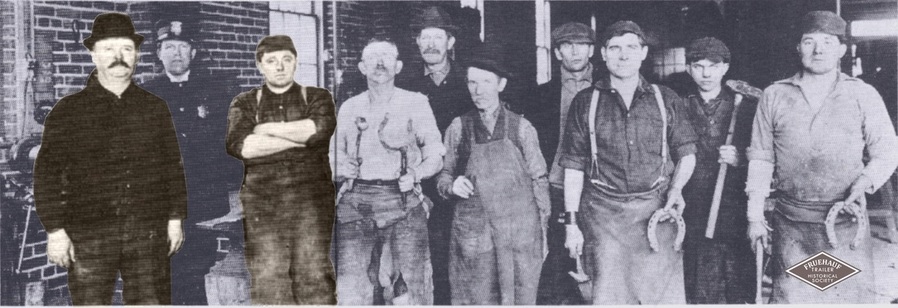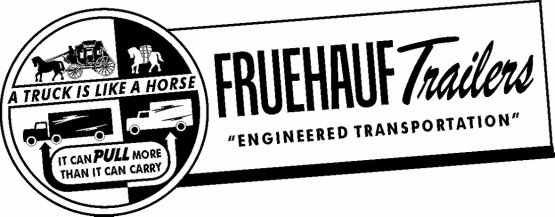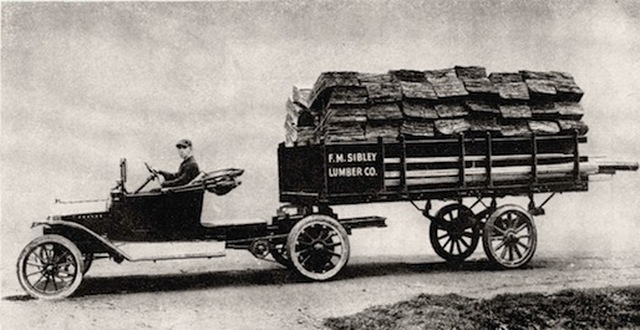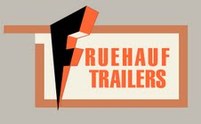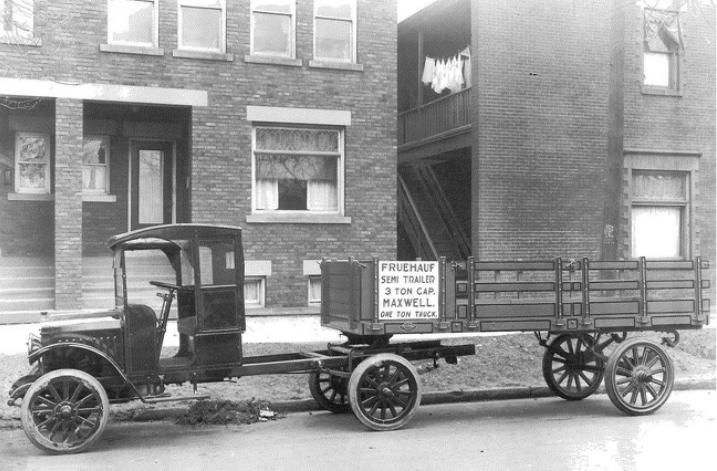Fruehauf Trailer Company Corporation History
"How important is Fruehauf Trailer Company in the trailer industry? To say it is the General Motors of the business understates the case. Not only was Fruehauf the biggest firm in the field, it sold more than all the others put together".
November 3, 1950 issue of "TIDE, The Newsmagazine for Advertising Executives"
November 3, 1950 issue of "TIDE, The Newsmagazine for Advertising Executives"
The Fruehauf Trailer Company Story
NEWCOMEN SOCIETY AWARD 1957 - The International Society for the History of Engineering and Technology
On January 23, 1957 Roy Fruehauf, son of August Charles Fruehauf, gave a speech before the National Newcomen Society in New York City. He was the guest of honor in celebration of the 60th anniversary of the Fruehauf Trailer Company. The following are excerpts from the speech Roy gave in honor of his father and his legacy. While we are passionate about the history of the Fruehauf Trailer company, Roy Fruehauf's speech illustrates the Fruehauf story in a unique way.
“Ten years before Charles Duryea invented America’s first successful automobile in Springfield, Massachusetts, or Dr. Rudolph Diesel patented an engine that still bears his name, a 14-year-old Michigan farm youth quit his rural home to seek his fortune in the city. The city was Detroit. The year, 1882. The youth, August Fruehauf—my father. Father got as far as East Detroit—and took a job there as a blacksmith’s apprentice. It was the first demonstration of his love for transportation—a love that was to last a lifetime.”
After the loss of two homes and shops to fire, August Fruehauf and wife Louisa relocated their growing family to Detroit and set up another blacksmith shop. The year was 1899. “Dad worked hard. He stuck to his anvil and forge from dark to dark. He made his name and quality synonymous. He started building wagons, too. In 1901—five years after Ford’s first car was built—Dad rented another piece of land—and with his own hands, and those of mother’s kinfolk who came in for a weekend ‘building bee,’ they built a two-story blacksmith shop.
“But by 1912 father’s business had outgrown that wondrous shop. So he walked across the street to a vacant lot, paced off the site—and then looked up the owner and bought the land. There he built the finest brick blacksmith shop in the United States of America, with big bay windows in front and a shop so long that it could house 60 horses at one time.
“In mid-1914, Frederic M. Sibley, Sr., a Detroit lumber tycoon, came to see my father about a problem. It was a fateful visit—for he was to change the company’s destiny—and carry it far beyond the horse and into the motor age. Mr. Sibley had acquired a summer place on a lake in upper Michigan. He had a fine boat he wanted to get there—but a horse and wagon would take days and days. Did my father think he could rig up a contraption to hook on to Mr. Sibley’s Model-T Ford roadster to haul the boat? My father and Otto Neumann thought they could.
After the loss of two homes and shops to fire, August Fruehauf and wife Louisa relocated their growing family to Detroit and set up another blacksmith shop. The year was 1899. “Dad worked hard. He stuck to his anvil and forge from dark to dark. He made his name and quality synonymous. He started building wagons, too. In 1901—five years after Ford’s first car was built—Dad rented another piece of land—and with his own hands, and those of mother’s kinfolk who came in for a weekend ‘building bee,’ they built a two-story blacksmith shop.
“But by 1912 father’s business had outgrown that wondrous shop. So he walked across the street to a vacant lot, paced off the site—and then looked up the owner and bought the land. There he built the finest brick blacksmith shop in the United States of America, with big bay windows in front and a shop so long that it could house 60 horses at one time.
“In mid-1914, Frederic M. Sibley, Sr., a Detroit lumber tycoon, came to see my father about a problem. It was a fateful visit—for he was to change the company’s destiny—and carry it far beyond the horse and into the motor age. Mr. Sibley had acquired a summer place on a lake in upper Michigan. He had a fine boat he wanted to get there—but a horse and wagon would take days and days. Did my father think he could rig up a contraption to hook on to Mr. Sibley’s Model-T Ford roadster to haul the boat? My father and Otto Neumann thought they could.
“Piece by piece they beat out and bolted a sturdy two-wheeler that they hooked to the rear of Mr. Sibley’s Model-T frame with a pole that acted both as tongue and brake. They called it a trailer. The trailer got the boat to Sibley’s lake. And Mr. Sibley, impressed by its performance, decided that such a rig—with a platform—would be most efficient for running about his lumber yard—getting together odds and ends orders—and delivering them. He reasoned he’d save man hours and horse feed—and could make a lot more trips more efficiently.
“So my father built Mr. Sibley a stronger trailer with a platform. It worked just as Mr. Sibley thought it would. Fruehauf trailers now were really on the American road. Orders began to come in with a rush. And there were many problems, too. But the Fruehauf team managed somehow to solve them. The trailer was constantly improved. One of the additions was a fifth wheel—which led to the automatic coupling of today.
“So my father built Mr. Sibley a stronger trailer with a platform. It worked just as Mr. Sibley thought it would. Fruehauf trailers now were really on the American road. Orders began to come in with a rush. And there were many problems, too. But the Fruehauf team managed somehow to solve them. The trailer was constantly improved. One of the additions was a fifth wheel—which led to the automatic coupling of today.
“By 1918, Father found that despite a day and night shift, orders were still outstripping production. With sales reaching $150,000 the blacksmith shop was literally bulging at its bay windows with workmen and trailers.
“New land and a new plant became mandatory. So did additional cash. On February 27, 1918, the Fruehauf Trailer Company was incorporated. Of the total $108,000 paid in for stock—only $7,935.32 was in cash. The rest was in real estate, tools, bills receivable, and inventories. It is interesting to note that the inventory didn’t list a single horseshoe. My father became Fruehauf’s first official President. My mother was Vice-President, my brother, Harvey, Treasurer and Sales Manager, and Otto Neumann, Factory Manager. By 1925, sales of the Fruehauf Trailer Company passed the million-dollar mark for the first time when they reached $1,215,000.
“Each year we grew a bit—each year more and more Fruehauf trailers began to take their places on the American road—and each year more and more of the things we Americans eat, wear, and use were carried in trailers bearing the name my father had made such a vital part of American business life. In 1937, a total of 4-million trucks and trailers were on our highways. The Second World War gave trucking another tremendous boost as our armed forces relied heavily on this ‘go anywhere’ type of transportation. Fruehauf alone designed and built 125 different types of trailers for the men under arms.
“By 1954—when the Fruehauf company had 9 plants and 88 branches in operation in the United States and Canada—as well as plants in Brazil and France—sales reached $152,000,000, the highest figure in our history up to that time. Today, trucking is America’s largest industrial employer. It provides one of every 10 jobs, and spends $30 billion annually on wages and materials. Truck owners pay over one-third of all the motor vehicle taxes, and purchase more than 10-billion gallons of gasoline a year.
“The years ahead promise even greater achievements—greater service to the Nation—for both Fruehauf and the Country’s motor transport industry.”
“Each year we grew a bit—each year more and more Fruehauf trailers began to take their places on the American road—and each year more and more of the things we Americans eat, wear, and use were carried in trailers bearing the name my father had made such a vital part of American business life. In 1937, a total of 4-million trucks and trailers were on our highways. The Second World War gave trucking another tremendous boost as our armed forces relied heavily on this ‘go anywhere’ type of transportation. Fruehauf alone designed and built 125 different types of trailers for the men under arms.
“By 1954—when the Fruehauf company had 9 plants and 88 branches in operation in the United States and Canada—as well as plants in Brazil and France—sales reached $152,000,000, the highest figure in our history up to that time. Today, trucking is America’s largest industrial employer. It provides one of every 10 jobs, and spends $30 billion annually on wages and materials. Truck owners pay over one-third of all the motor vehicle taxes, and purchase more than 10-billion gallons of gasoline a year.
“The years ahead promise even greater achievements—greater service to the Nation—for both Fruehauf and the Country’s motor transport industry.”
August Fruehauf - General Blacksmithing and Wagon Repair
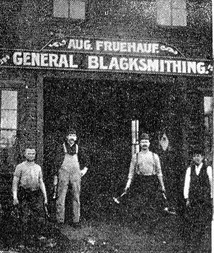
In reference to Roy’s vision of the future his speech continued, “Many units in these fleets will be powered by the atom. There’ll be more plastic trailers—and other trailers, with the use of light-weight metals like titanium, will be carrying even greater payloads. These trucks and trailers will be equipped with every conceivable safety device—many of them not yet on the drawing boards. Piggybacking, the carrying of loaded truck-trailers on railway flat cars, will be the biggest single revenue producing factor for the Nation’s railroads.
"Long before 1966, the railroads will have replaced the Nation’s 716,000 box cars with flat cars each carrying two truck trailers. Fishybacking, the carrying of loaded truck-trailers and trailer containers on steamships, will grow to great importance along both Coasts and the St. Lawrence Seaway. Trailerships will become more numerous. By 1966, trucks and trailers will be carrying an overwhelming percentage of the Nation’s total freight load. On runs up to 300 miles, trucks and trailers will be carrying 99 percent of the Country’s mail. In 1966, in the Nation’s factories, truck-trailers, an essential part of present day automation methods, will have an even greater role in producing more at less unit cost.
“I know you will agree that these are exciting forecasts. These are exciting times. But they are sobering times, too. Fruehauf truck-trailers are not only on duty day and night on the American road, but wherever an American soldier, sailor, airman, and marine is on duty around the world Fruehauf truck-trailers are with them. The truck-trailer and the guided missile may not look like kinfolk, but they are. So are the trailer and the jet airplane. This is a time when the ‘essential values of man are in extreme danger.’ We must be strong—and we must be free—because, as Wendell Willkie said so ably a number of years ago ‘only the free can be strong.’
“With atomic energy being harnessed…with jet speed records being created nearly every week…and electronics doing miraculous things…we all have an unmistakable challenge not only to keep pace…but to keep ahead. The future concerns all of us, because, as my friend, Charles F. Kettering said, ‘there’s where we are going to spend the rest of our lives.’"
"Long before 1966, the railroads will have replaced the Nation’s 716,000 box cars with flat cars each carrying two truck trailers. Fishybacking, the carrying of loaded truck-trailers and trailer containers on steamships, will grow to great importance along both Coasts and the St. Lawrence Seaway. Trailerships will become more numerous. By 1966, trucks and trailers will be carrying an overwhelming percentage of the Nation’s total freight load. On runs up to 300 miles, trucks and trailers will be carrying 99 percent of the Country’s mail. In 1966, in the Nation’s factories, truck-trailers, an essential part of present day automation methods, will have an even greater role in producing more at less unit cost.
“I know you will agree that these are exciting forecasts. These are exciting times. But they are sobering times, too. Fruehauf truck-trailers are not only on duty day and night on the American road, but wherever an American soldier, sailor, airman, and marine is on duty around the world Fruehauf truck-trailers are with them. The truck-trailer and the guided missile may not look like kinfolk, but they are. So are the trailer and the jet airplane. This is a time when the ‘essential values of man are in extreme danger.’ We must be strong—and we must be free—because, as Wendell Willkie said so ably a number of years ago ‘only the free can be strong.’
“With atomic energy being harnessed…with jet speed records being created nearly every week…and electronics doing miraculous things…we all have an unmistakable challenge not only to keep pace…but to keep ahead. The future concerns all of us, because, as my friend, Charles F. Kettering said, ‘there’s where we are going to spend the rest of our lives.’"
Fruehauf Trailer Company dominated the semi-trailer industry and never had any significant competition outselling their nearest competitor by almost 80%. August Fruehauf's motto, "Built to Last" was incorporated by the research and design team as they developed new and improved methods of transporting American goods around the world.

